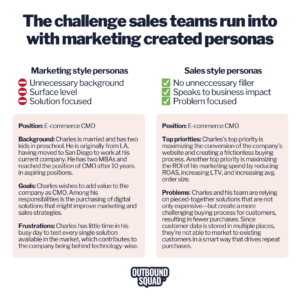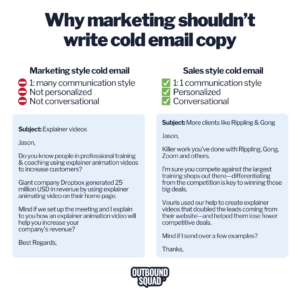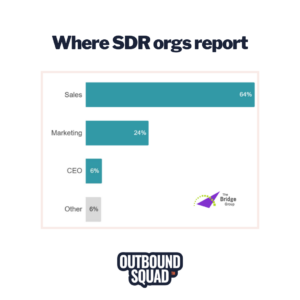How Brooksource's 180+ AEs self-source pipeline (with zero SDR support) and convert cold calls at 35%
👇
Brooksource doesn't sell SaaS. They sell professional services.
For my tech sales teams out there—we can learn a lot from how they outbound.
Their AEs self-source 100% of their pipeline. Zero SDR support. And they close big enterprise deals.
Here's how they approach outbound for their AEs:
✅ Start with Leadership enablement
They enable leaders FIRST before training the reps. Every single leader understands the process, can execute it themselves, and knows how to coach their reps.
💡 Insight: Don't fall prey to a "blind leading the blind" situation. Enable leadership before enabling reps.
✅ Prescriptive guidance on targeting
Brooksource is a very data-driven company. Their ops team tracks everything.
They can tell you, by rep, everything from outbound activity...to meetings set...to late-stage sales meetings set...and their conversion rates. Most SaaS orgs couldn't give an accurate snapshot of their AEs self-sourcing efforts.
Then they take it a layer deeper.
Their leaders know exactly what types of accounts are best. Who to get conversations started with. And most importantly, what's a bad fit that should be ignored.
💡 Insight: Give reps very specific guidance on territory planning and where it's best to spend their time
✅ Provide killer cold call talk tracks
They believe that prospects don't care about their solutions until they know you understand their problems.
For every persona, they supply high-level talking points:
- Trends
- Common problems
- Typical business priorities
etc.
When their reps pick up the phone, they can be laser-focused on messaging. And the entire sales org. can rally around a common, standardized approach to the phones.
This alone increased their live conversation to booked meeting conversion from 22-35%. 35% is top 1%-er stuff. You rarely see an entire sales team convert at that level.
💡 Insight: Gather common priorities for every persona in every industry vertical. Wordsmith with your best reps/leaders. Then roll out to the entire team.
~~~
Mitch Thomas heads up enablement at Brooksource. They're one of the best examples of an organization that doesn't just talk about AE self-sourcing—they live it. And I've seen it first-hand.
Catch our conversation here: https://outboundsquad.com/jason-bay-339/
Running competitor takedown campaigns? Don't make these mistakes
👇
Let's get a list of every target account using a competitor. Then go directly at them talking about how much better we are.
Sounds great in theory, right?
But rarely—I mean, you're getting lucky—if that approach works for your sales org.
A company will only switch solutions under this circumstance:
They're experiencing buyer's regret. Which happens 56% of the time in SaaS (Gartner).
Buyer's regret happens for multiple reasons:
- Low adoption
- Feature gaps
- Poor customer service
- etc.
Ultimately, they're not achieving the outcomes they signed up for.
If you're running competitive takedown campaigns, don't make these mistakes:
⛔️ 1:many approach across a huge list
1:many without serious thought about segmentation isn't very effective.
Don't make the mistake of building a target account list with hundreds/thousands of folks using your competitors.
Then letting reps go hog wild on a mass blast cold email campaign.
✅ What to do instead: Build small segments
Find small pockets within those accounts that you can speak to in the same way:
1) Current customers who have piecemealed together your solution with a competitor
2) Break the account list down by specific competitors
3) Accounts showing intent
4) Accounts with previous closed/lost deals (bonus points if you get specific with the closed/lost reason: missing features you have now, budget, didn't get to power, etc.)
5) Accounts where you have executive connections
6) Accounts with previous customers
etc.
Get very specific so you can tailor messaging more easily.
⛔️ Feature battle
"Our competitor doesn't have this ______ feature...and we do!"
Hold up there, sparky. Again, sounds great in theory but needs to be taken to the next level.
End users might care about specific features, but executives do not.
✅ Tailor messaging to the persona
Start by listing the top 3 areas of differentiation between you and the competitor.
Don't stop there. Now list out the problems & impact those prospects are likely having without your solution.
That's what you lead with.
Example:
Differentiation: You have one-click checkout, your competitors do not
Problem/Impact: Conversion rate on the website is half of what it could be, fewer customers make purchases. You lose sales, waste marketing dollars, etc.
The message should be less: "We offer one-click checkout, and our competitors don't..."
And more: "The top DTC shoe brands allow customers to purchase in one-click—a strategy that significantly reduces the odds of a customer adding an item to their cart and never checking out..."
~~~
There's a ton more to competitor takedown campaigns. But this is a good start.
Want more?
I'm running a free training with Anthony Iannarino, Ralph Barsi, and Ryan Oostervald from ZoomInfo next Wed 7/24.
The topic: Displacing Competitors: How to eat your competitor's lunch
Register here to join us: https://hubs.ly/Q02Dds1G0
Marketing and product should not be creating personas for sales. Here's why...
👇
Marketing is great at 1:many communication:
- Content
- Conversion (website, landing pages, etc.)
- Paid campaigns
But sales is all about 1:1 conversations:
- Outbound emails & calls
- Discovery conversations
- Demos
- Negotiations
etc.
1:many language doesn't translate well into sales conversions.
If you rely on marketing-created personas in sales, you'll run into these problems:
⛔️ Low reply rates to cold emails
⛔️ Low-performing sequences
⛔️ Trouble getting access to power in deals
⛔️ Generic, boring sales decks
⛔️ Long ramp times for new reps (especially young SDRs)
My suggestion?
Use what marketing creates as a starting point. And then take it to the next level.
Every persona should have the following:
✅ Priorities
Common priorities you would align the solution to. Speak to the most typical executive priorities your customers have across specific products.
✅ Current solutions
Common solutions to those problems. The people, process, tech they use to get the job done.
✅ Problems
How the current solutions get in the way of the priority. Speak to the impact and "so what?"
✅ Desired future state
What the prospect ultimately hopes to accomplish.
✅ Segmented by industry or company size
On an enterprise level, you might go even deeper and create messaging like this across specific industry verticals and company sizes.
Example: A CFO at a F500 manufacturer is different from the CFO of a bank.
~~~
As the sales org, it's your responsibility to take marketing personas a layer or two deeper.
Do this and you'll see much better results from your outbound and selling efforts.

Marketing shouldn't write cold email sequences. Here's why...
👇
I said this before, and I'll say it again: I love my marketers out there. And I consider myself a marketer.
But marketers have to stop writing cold emails.
Whenever I see a poorly performing sequence—the first think I ask is who wrote them.
And almost always, the marketing or demand gen team owns the email copy.
Marketing is great at 1:many —
✅ Creating inbound interest through content
✅ Capturing interest and demand
✅ Creative differentiation and positioning in the marketplace
Marketing is not great at 1:1 —
⛔️ Cold email copy
⛔️ Cold call talk tracks
⛔️ Sales conversations
So, PLEASE PLEASE let sales own sales messaging. Anything outbound related should be owned by sales with the assistance of marketing.
The image below shows the difference between a marketing and sales written cold email.
Those marketing emails will get <1% reply rates. And the sales emails can get double-digit reply rates.
Take your pick.

Outbound SDR teams should not report to marketing. Here's why...
👇
I love my marketers out there. I've sat in the seat before. And consider myself a marketer.
But I've NEVER seen a marketing-created sequence with a reply rate higher than .5%.
This isn't about egos and whether marketing or sales is more important.
It's about staying in your lane.
Marketing crushes the 1:many game of building awareness & demand.
Sales crushes the 1:1 conversation. And turning demand into pipeline and revenue.
⛔️ 1) Marketing should not own outbound messaging
Sales should not need approval from marketing for their sequences. Sales should have full autonomy (with support from marketing) on outbound messaging for sequences.
Sales is having the 1:1 conversations. And outbound is 1:1 communication.
⛔️ 2) Marketing isn't as skilled at managing a quota
At the IC level, marketers do not typically have quotas. And their leaders don't typically have experience managing sales reps with quotas.
SDRs need to be managed just like full-cycle sales reps.
⛔️ 3) Marketing typically misses the objective with outbound
Outbound is not an "awareness" building activity.
Outbound is a "set meetings" activity. Full stop.
The only reason to do outbound is to make contact, set meetings, and build pipeline.
Sales is more aligned to this incentive.
~~~
Again, I love marketing. And outbound should be a collaborative activity between sales and marketing.
64% of SDR orgs report to Sales right now (Bridge Group). And that number should continue growing.
Sales needs to own outbound.

“Send me an email.”
Here’s how to handle this objection:
✅ Step 1: Reality check
Once you hang up the phone, the success rate of landing a meeting goes down dramatically.
There’s literally <1% success rate of sending an email that blows the socks off your prospect so much they respond with:
“KILLER email! Yes, let’s talk. Are you available right now?”
Play the odds. You’re better off asking for the meeting again.
✅ Step 2: Comply
Prospect: “Can you send me an email?”
Rep: “Sure thing, happy to.”
Doing so disarms the prospect. And that’s all you can ask for when objection handling during a cold call. Genuine conversation. That’s the goal.
✅ Step 3: Get more info
Now it’s time to dig in. Your goal is to anchor back to a legitimate reason for the prospect to meet with you.
Prospect: “Can you send me an email.”
Rep: “Sure thing, happy to. So I can get the right info to you—are you like most HR leaders in that your team is absolutely swamped with manual tasks running payroll, benefits, etc. across five different tools?"
Then dig in for as much as the prospect is willing:
- Find out their current solution
- See if they have similar problems that your clients have
✅ Step 4: Ask for the meeting
Now it’s time to anchor what you just learned to the reason for meeting.
Rep: “Got it, this is exactly what we’ve helped ABC and XYZ companies with. Their HR teams were getting bogged down with manual admin. work across the five solutions they pieced together for payroll, benefits, onboarding, etc. How about this—most of the material we send over can be very generic and unhelpful. A more effective use of your time would be to spend time with one of our HR specialists to look at this through a lens that’s more specific to your business. Do you have your calendar handy?”
This usually does the trick
✅ Step 5: How to handle resistance
Still getting resistance? Try this:
Rep: “Okay, no worries. How about we put 5 minutes on the calendar for tomorrow when you’ve had a chance to look over the email? If you like what you see, we keep the meeting. If you don’t, you can cancel. Sound fair?”
==============
And that’s how you handle the “send me an email” objection.